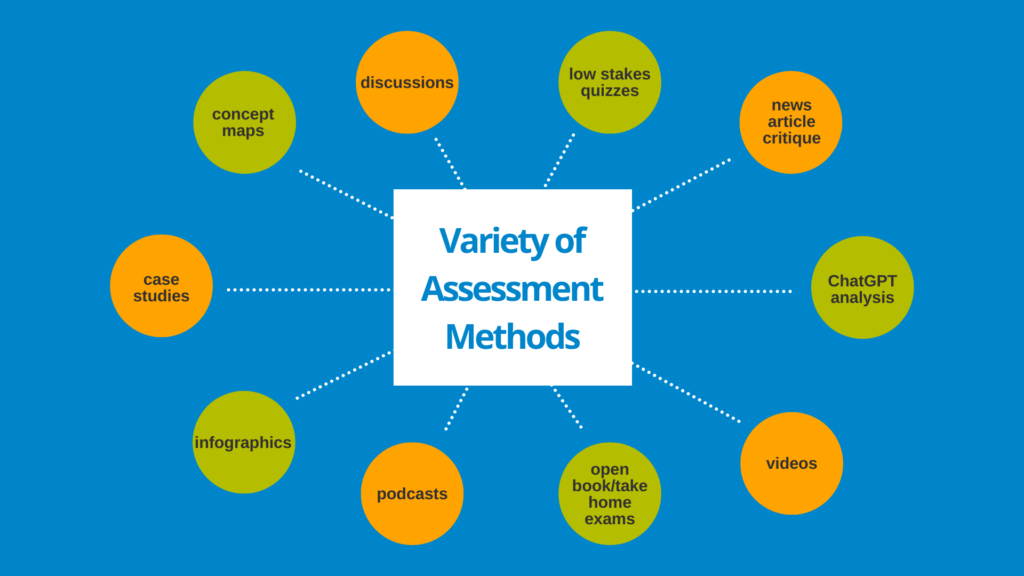What is Flexible Assessment?
Flexible assessment can take many forms. The flexibility may come from format, due dates or topic. It can apply to individual assignments or the assessment plan for your entire course. However, the success of any approach to flexible assessment will stem from the development of clearly established learning outcomes.
Why Adopt Flexible Assessment?
Student Engagement
Empowering students to make choices in how they are assessed is one way to help them create a personal connection to their learning. Imagine the difference between being handed a task to complete and being given a set of options to choose from. While the second option might be a bit more intimidating, you are more likely to be invested in it because you have to think about which choice to make.
Meet the Needs of Diverse Students
Different students learn in different ways. In fact, the way we learn is as unique as our fingerprints (CAST). It follows that the way that students express what they have learned will also be unique. Writing an essay might be the best way for one student to show that they have achieved the learning outcomes in the course while someone else in class might express their achievement better through the spoken word or a concept map. Some students excel at class discussions, while others show their learning better through reflection. Employing flexible assessment strategies makes it more likely that more students will have the opportunity to successfully show what they have learned.
What does Flexible Assessment Look Like?
Flexible assessment comes in many forms. Here are some ways that it can be done. They can be mixed and matched. There is also an infographic version available for this content.
Variety of Assignments
Different types of assignments will provide students with the opportunity to show their learning in different ways. Planning for a variety of formative and summative assessments provides more opportunities for students to show what they know. Consider how you are asking students to show their learning. Is there room for presenting a variety of assessment formats (e.g. visual, audio, presentation) while still meeting the outcomes of the course?

Choice within Assignments
Providing students with choice within an assignment is another strategy. This can mean choice in terms of topic, format or if they choose to work alone or collaboratively. Again, as long the learning outcomes for the course are clear it is possible to provide options without threatening the integrity of the assignment and the learning.
Weight Distribution
Another way to let students choose how to best show their learning is by letting them have input (within guidelines) for how their grades are distributed across assessments. This means that a student who knows they do not do well on exams may choose to have the class presentation weighted more heavily than the final exam.
Self-Directed Assignments
Some courses may lend themselves to having students creating their own assignment ideas. One way to do this would be to have students review the learning outcomes and/or a marking rubric for the course and propose an assignment they feel would meet those expectations. This proposal would then become the basis for some discussion and negotiation with the instructor to make sure the proposed assignment meets the course requirements.
Top Tips for Getting Started
- Start Small. If you like the idea of flexible assessment, but it seems overwhelming just choose one element of your assessment plan to modify. Even small changes can make assessment more inclusive and flexible.
- Identify what is not working. Is there an assessment in your course that your students struggle with? Is there one that you don’t think is working well? Maybe introducing some elements of flexible assessment can improve student success.
- Review and Refine Learning Outcomes. Have I mentioned learning outcomes already? It may sound repetitive, but clear statements about what your students will be able to do once they leave your course will make it much easier for you to assess student learning even if it does not look the same across students. This Flexible Assessment Self-Study Guide can help you analyze an existing course.
- Use Rubrics. If you create a rubric that aligns with the learning outcomes, then you should be able to use the same rubric to assess assignments that vary in topic and format. You can also share these rubrics with students and encourage them to self-assess ahead of submitting the assignment. You can learn more about using rubrics on our blog.
Frequently Asked Questions
If I incorporate flexible assessment, does that mean that I need to have a different way to mark each student?
No. If the assessment is clearly linked to learning outcomes for the course then one marking guide can be used.
If I adopt a flexible approach to assessment, do I need to provide multiple options for all my assessments?
No. Choose the flexible elements that fit with your overall course design and teaching style.
Not all students are comfortable with flexibility. What can I do for them?
Keep in mind that flexibility does not mean free for all. You will still be providing some structure in terms of learning outcomes, rubrics and assignment descriptions.
Want to Learn More?
Check out these additional resources:
- Bento to Buffet: Two Approaches to Flexible Summative Assessment [8 Page PDF)
- FLEX FORWARD: Multiple Assessment Options [Video: 2:44]
- Flexible assessment and student empowerment: advantages and disadvantages – research from an Australian university [17 Page Online Article with Audio Option]
- Making Assessments More Flexible & Accessible [Infographic]
Join a Conversation with Colleagues
If you would like to learn more about how you can increase student engagement and address the unique learning needs of your students, we invite you to sign up for a round table conversation facilitated by CIEL.
Flexible Assignments
10:00 am – 11:30 am, Friday, February 24, 2023